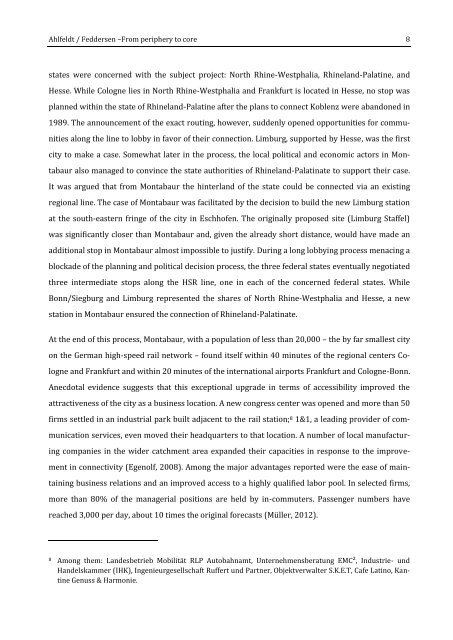sercdp0172
sercdp0172
sercdp0172
Create successful ePaper yourself
Turn your PDF publications into a flip-book with our unique Google optimized e-Paper software.
Ahlfeldt / Feddersen –From periphery to core 8states were concerned with the subject project: North Rhine-Westphalia, Rhineland-Palatine, andHesse. While Cologne lies in North Rhine-Westphalia and Frankfurt is located in Hesse, no stop wasplanned within the state of Rhineland-Palatine after the plans to connect Koblenz were abandoned in1989. The announcement of the exact routing, however, suddenly opened opportunities for communitiesalong the line to lobby in favor of their connection. Limburg, supported by Hesse, was the firstcity to make a case. Somewhat later in the process, the local political and economic actors in Montabauralso managed to convince the state authorities of Rhineland-Palatinate to support their case.It was argued that from Montabaur the hinterland of the state could be connected via an existingregional line. The case of Montabaur was facilitated by the decision to build the new Limburg stationat the south-eastern fringe of the city in Eschhofen. The originally proposed site (Limburg Staffel)was significantly closer than Montabaur and, given the already short distance, would have made anadditional stop in Montabaur almost impossible to justify. During a long lobbying process menacing ablockade of the planning and political decision process, the three federal states eventually negotiatedthree intermediate stops along the HSR line, one in each of the concerned federal states. WhileBonn/Siegburg and Limburg represented the shares of North Rhine-Westphalia and Hesse, a newstation in Montabaur ensured the connection of Rhineland-Palatinate.At the end of this process, Montabaur, with a population of less than 20,000 – the by far smallest cityon the German high-speed rail network – found itself within 40 minutes of the regional centers Cologneand Frankfurt and within 20 minutes of the international airports Frankfurt and Cologne-Bonn.Anecdotal evidence suggests that this exceptional upgrade in terms of accessibility improved theattractiveness of the city as a business location. A new congress center was opened and more than 50firms settled in an industrial park built adjacent to the rail station; 8 1&1, a leading provider of communicationservices, even moved their headquarters to that location. A number of local manufacturingcompanies in the wider catchment area expanded their capacities in response to the improvementin connectivity (Egenolf, 2008). Among the major advantages reported were the ease of maintainingbusiness relations and an improved access to a highly qualified labor pool. In selected firms,more than 80% of the managerial positions are held by in-commuters. Passenger numbers havereached 3,000 per day, about 10 times the original forecasts (Müller, 2012).8 Among them: Landesbetrieb Mobilität RLP Autobahnamt, Unternehmensberatung EMC², Industrie- undHandelskammer (IHK), Ingenieurgesellschaft Ruffert und Partner, Objektverwalter S.K.E.T, Cafe Latino, KantineGenuss & Harmonie.


